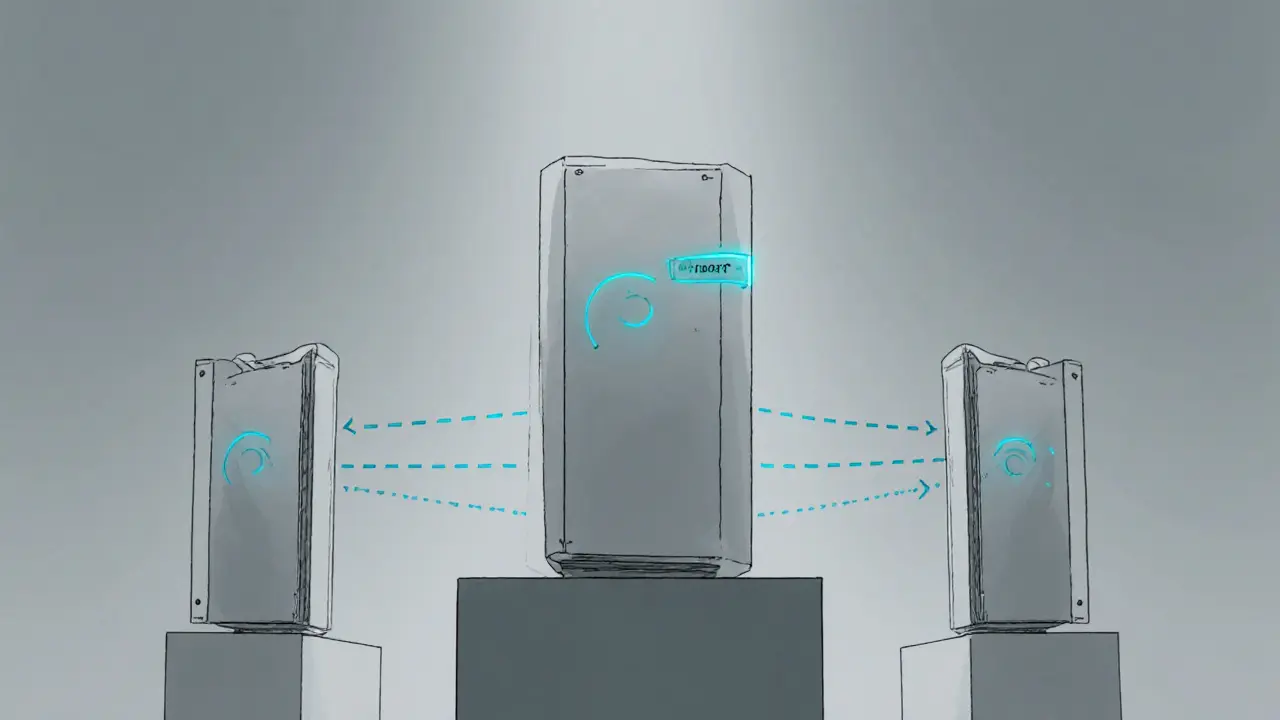Consensus Algorithm Comparison Tool
Byzantine Fault Tolerance (BFT)
Tolerates arbitrary (malicious) failures and can handle up to one-third of faulty nodes in a network.
- Fault Model: Arbitrary/malicious behavior
- Nodes Required: 3f+1 to tolerate f faulty nodes
- Message Complexity: O(n²) per round
- Latency: 3-5 network round-trips
- Use Cases: Public blockchains, multi-org consortia
Traditional Consensus (e.g., Raft)
Tolerates only crash failures and assumes nodes either function correctly or stop responding.
- Fault Model: Crash-only failures
- Nodes Required: 2f+1 for majority
- Message Complexity: O(n) per round
- Latency: 1-2 network round-trips
- Use Cases: Cloud services, internal databases
Decision Factors
When you’re building a distributed system, the choice between a Byzantine‑fault‑tolerant approach and a classic crash‑fault consensus can make or break security, performance, and cost. Below you’ll get a clear picture of what each model does, where they shine, and how to decide which one fits your project.
What is Byzantine Fault Tolerance?
Byzantine Fault Tolerance is a property of a distributed system that allows it to reach agreement even when up to one‑third of its nodes act arbitrarily-maliciously, faulty, or simply lie about information. The term stems from the Byzantine Generals Problem, a thought experiment that shows how difficult it is for commanders to coordinate an attack when some messengers may be corrupted. In practice, BFT means a protocol can survive f faulty nodes in a network of 3f+1 participants, guaranteeing both safety (no two honest nodes decide differently) and liveness (the system eventually decides).
Traditional Consensus Mechanisms Overview
Traditional Consensus covers algorithms that assume failures are limited to crashes or network partitions, not malicious misbehavior. The most common examples are Paxos, Raft, and simpler majority‑vote schemes used in many cloud services. These protocols work under the crash‑fault model: a node either functions correctly or stops responding. Because they don’t need to guard against arbitrary lies, they are generally faster and easier to implement.
Core Differences Between BFT and Traditional Consensus
- Fault model: BFT tolerates Byzantine (arbitrary) faults; traditional consensus tolerates only crash faults.
- Node count requirement: BFT needs at least 3f+1 nodes to tolerate f bad actors, while traditional consensus works with a simple majority (>50%).
- Message complexity: BFT protocols typically exchange O(n²) messages per round; traditional algorithms like Raft achieve O(n) messages.
- Performance: In trusted environments, Raft can commit in two network round‑trips, whereas BFT often requires three or more phases (pre‑prepare, prepare, commit).
- Implementation difficulty: BFT needs cryptographic signatures, multiple phases, and careful timeout handling; traditional consensus relies on simpler leader election and log replication.
Performance & Scalability Trade‑offs
Because BFT must guard against deceptive behavior, it pays a price in bandwidth and latency. For a network of 100 nodes, a vanilla BFT run can send upwards of 10,000 messages per consensus round, while Raft would send under 200. This overhead grows quadratically, making pure BFT impractical for large public blockchains without tweaks.
To mitigate the cost, many projects combine BFT with a smaller voting committee (e.g., delegated proof‑of‑stake) or use sharding to limit the number of participants per round. On the flip side, traditional consensus shines in environments where the participants are known and trusted-think data‑center clusters, internal microservice meshes, or enterprise databases.

Real‑World Implementations
Practical Byzantine Fault Tolerance (pBFT) is a widely studied BFT algorithm that uses three phases-pre‑prepare, prepare, commit-to achieve agreement with up to one‑third malicious nodes. pBFT was the backbone of early permissioned blockchains like Hyperledger Fabric, but its O(n²) messaging made scaling beyond a few dozen validators costly.
In the public blockchain world, Proof of Work (PoW) relies on computational puzzles to make attacks economically infeasible, indirectly providing Byzantine fault tolerance. Bitcoin’s PoW ensures that an attacker would need >50% of the total hash power to rewrite history. While secure, PoW burns energy and has high latency (minutes per block).
Proof of Stake (PoS) uses economic stake as collateral; validators lose their deposit if they try to cheat, providing a financial deterrent against Byzantine behavior. Ethereum’s PoS (the Beacon Chain) still needs a BFT‑style finality gadget (Casper) to guarantee safety.
Raft is a crash‑fault consensus algorithm that elects a leader, replicates a log, and guarantees safety with a simple majority. Raft powers many cloud databases (e.g., etcd, Consul) because it is easy to reason about and has low overhead.
Hybrid designs are becoming common: a permissioned chain may run pBFT among a small validator set for finality, while delegating transaction ordering to a PoS layer that handles throughput.
Choosing the Right Approach
- Assess the threat model. If participants can be malicious (public blockchain, multi‑organization consortium), lean toward BFT or a BFT‑augmented PoS/PoW system.
- Measure network size. For networks under ~30 nodes, pure pBFT is feasible; beyond that, consider committee‑based BFT or traditional consensus.
- Prioritize latency vs security. Raft gives sub‑second commit times but offers no protection against rogue nodes. BFT adds seconds of latency but prevents double‑spend attacks.
- Factor in operational cost. BFT needs authenticated messaging (signatures, PKI) and more bandwidth. Traditional consensus needs less compute and can run on modest hardware.
- Look at ecosystem tooling. Raft enjoys mature libraries (etcd, HashiCorp). BFT libraries exist (Tendermint, Hyperledger) but often require deeper expertise.
In practice, many projects start with a simple crash‑fault consensus for internal services and later adopt a BFT layer when they expose APIs to untrusted users.
Side‑by‑Side Comparison
| Aspect | Byzantine Fault Tolerance (e.g., pBFT) | Traditional Consensus (e.g., Raft) |
|---|---|---|
| Fault model | Arbitrary/Byzantine (malicious or buggy) | Crash‑only (node stops) |
| Minimum nodes for f faults | 3f+1 (can tolerate f bad nodes) | 2f+1 (majority needed) |
| Message complexity per round | O(n²) | O(n) |
| Typical latency | 3‑5 network round‑trips | 1‑2 round‑trips |
| Implementation difficulty | High (cryptography, multi‑phase) | Medium (leader election, log replication) |
| Common use‑cases | Public blockchains, permissioned ledgers, multi‑org consortia | Cloud services, internal databases, microservice coordination |
| Scalability limit | Usually <100‑200 validators without sharding/committees | Thousands of nodes (e.g., etcd clusters) |
Key Takeaways
- Byzantine Fault Tolerance protects against malicious actors but costs bandwidth and latency.
- Traditional consensus is faster and simpler but only works when participants are trusted.
- Pick BFT for public, trustless environments; choose Raft or similar for internal, performance‑critical systems.
- Hybrid models (BFT + PoS/PoW) are gaining traction to balance security and throughput.
- Always match the algorithm to your threat model, network size, and operational budget.
Frequently Asked Questions
Can a traditional consensus algorithm be made Byzantine‑fault tolerant?
Not directly. Traditional algorithms assume crash faults, so they lack the cryptographic checks needed to detect lying nodes. However, you can layer a BFT finality gadget on top of a crash‑fault protocol to gain Byzantine safety.
Why does pBFT have O(n²) message complexity?
During each phase (pre‑prepare, prepare, commit), every replica must broadcast its view to every other replica to ensure agreement. That all‑to‑all communication squares the number of messages as the node count grows.
Is Raft suitable for a public blockchain?
Usually not. Raft trusts that the majority of nodes are honest, which conflicts with the open, permissionless nature of public blockchains where anyone can join and act maliciously.
What’s the biggest challenge when deploying BFT in production?
Managing network bandwidth and latency as the validator set grows. Teams often mitigate this by limiting the voting committee, using sharding, or adopting hybrid consensus stacks.
How does Proof of Stake achieve Byzantine safety?
Validators lock up tokens as collateral. If they propose invalid blocks or try to double‑spend, the protocol slashes (confiscates) a portion of their stake, making attacks economically unattractive.

